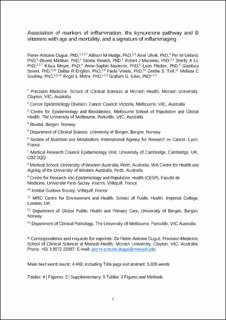Association of Markers of Inflammation, the Kynurenine Pathway and B Vitamins with Age and Mortality, and a Signature of Inflammaging
Dugué, Pierre-Antoine; Hodge, Allison M.; Ulvik, Arve; Ueland, Per Magne; Midttun, Øyvind; Rinaldi, Sabina; MacInnis, Robert J.; Li, Sherly X.; Meyer, Klaus; Navionis, Anne-Sophie; Flicker, Leon; Severi, Gianluca; English, Dallas R.; Vineis, Paolo; Tell, Grethe S.; Southey, Melissa C.; Milne, Roger L.; Giles, Graham G.
Journal article, Peer reviewed
Accepted version

View/
Date
2022Metadata
Show full item recordCollections
- Department of Clinical Science [2395]
- Registrations from Cristin [10402]
Original version
The journals of gerontology. Series A, Biological sciences and medical sciences. 2022, 77 (4), 826–836. https://doi.org/10.1093/gerona/glab163Abstract
Background
Inflammation is a key feature of aging. We aimed to (i) investigate the association of 34 blood markers potentially involved in inflammatory processes with age and mortality and (ii) develop a signature of “inflammaging.”
Methods
Thirty-four blood markers relating to inflammation, B vitamin status, and the kynurenine pathway were measured in 976 participants in the Melbourne Collaborative Cohort Study at baseline (median age = 59 years) and follow-up (median age = 70 years). Associations with age and mortality were assessed using linear and Cox regression, respectively. A parsimonious signature of inflammaging was developed and its association with mortality was compared with 2 marker scores calculated across all markers associated with age and mortality, respectively.
Results
The majority of markers (30/34) were associated with age, with stronger associations observed for neopterin, cystatin C, interleukin (IL)-6, tumor necrosis factor alpha (TNF-α), several markers of the kynurenine pathway and derived indices KTR (kynurenine/tryptophan ratio), PAr index (ratio of 4-pyridoxic acid and the sum of pyridoxal 5′-phosphate and pyridoxal), and HK:XA (3-hydroxykynurenine/xanthurenic acid ratio). Many markers (17/34) showed an association with mortality, in particular IL-6, neopterin, C-reactive protein, quinolinic acid, PAr index, and KTR. The inflammaging signature included 10 markers and was strongly associated with mortality (hazard ratio [HR] per SD = 1.40, 95% CI: 1.24–1.57, p = 2 × 10−8), similar to scores based on all age-associated (HR = 1.38, 95% CI: 1.23–1.55, p = 4 × 10−8) and mortality-associated markers (HR = 1.43, 95% CI: 1.28–1.60, p = 1 × 10−10), respectively. Strong evidence of replication of the inflammaging signature association with mortality was found in the Hordaland Health Study.
Conclusion
Our study highlights the key role of the kynurenine pathway and vitamin B6 catabolism in aging, along with other well-established inflammation-related markers. A signature of inflammaging based on 10 markers was strongly associated with mortality.